These oversized octopus stickers on the wall outside the Shibuya Parco building are dangerously close to the swimwear display.
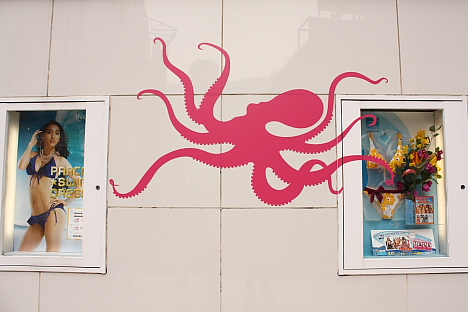
[Enlarge]
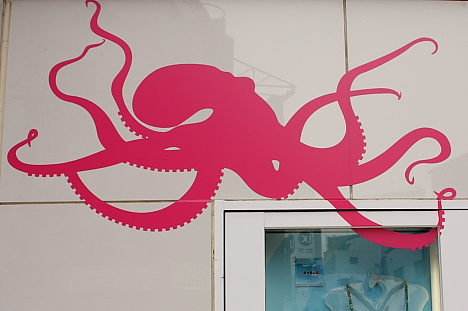
[Enlarge]

A delightfully odd form of communication is at work here in this music video for Supercar's "Wonder Word." Directed by Koichiro Tsujikawa.

Has Japan Airlines' crop-based advertising gone too far? For some residents of Inakadate -- a small town with a big reputation for cultivating fantastic works of multi-colored rice paddy art -- the answer is "yes."
This year's crop art, which is Inakadate's 16th work since 1993, features giant images of Daikoku (god of wealth) and Ebisu (god of fishers and merchants) alongside the corporate logo for sponsor Japan Airlines (JAL). Here are a few photos of the rice paddy taken in June from the 6th-floor roof of the adjacent town hall.
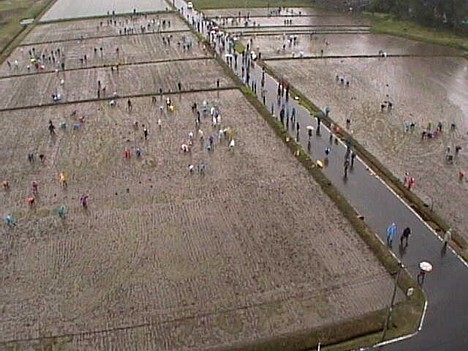
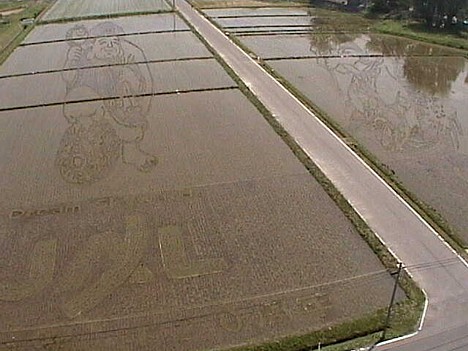



Daikoku (left), Ebisu (right) and JAL logo
The town committee responsible for the annual crop art project decided to incorporate advertising into this year's work to help offset rising costs associated with increased numbers of visitors. Last year more than 240,000 people came to see the crop art, and many of them used the town hall bathrooms and elevators (there is a nice view of the rice paddy from the roof), resulting in a costly utility bill.
However, the owner of the rice field, Ryuji Sato -- who also happens to be the former mayor of Inakadate and a member of the committee -- thinks the ad stinks. At the end of June he demanded the corporate logo be removed from his property.
"The idea has always been to create art that attracts lots of visitors and stimulates the economy," says Sato. "Turning it into a giant advertisement contradicts what we set out to do."
After a week of heated discussion, the committee voted to pull the ad, and on the morning of July 4, town hall employees were dispatched to the field to uproot the rice plants that make up the JAL logo. TV crews were on the scene. (Watch a Fuji TV news report.)
The video shows people removing rice plants only from the area occupied by the JAL symbol, which creates a very conspicuous negative space in the field. Ironically, this makes the logo more visible. It remains to be seen whether they can successfully remove all traces of the ad.

Town hall employees remove JAL logo
Sato's critics are skeptical of his motives. Because he is on the ballot for this autumn's upcoming mayoral election, some believe he is trying to draw attention to his candidacy. Others think he may be taking revenge for the bitter 2004 mayoral election loss that removed him from office. Sato dismisses the criticism, saying that if he really wanted revenge, he would not have allowed the art to be grown in his field in the first place.
"I just can't stand the fact that they are trying to turn this into a commercial venture," says Sato, who hopes to see the rice paddy art tradition continue as it has in the past.
Meanwhile, the Aomori-based marketing agency that coordinated the advertising agreement with JAL does not know what to make of the situation. A company spokesperson says, "We obtained the committee's approval and signed a formal agreement, but yet it has come to this. We are baffled."
[Sources: Inakadate Village, To-o Nippo]
Police in Nagasaki, Japan have arrested a man for developing a sophisticated robotic arm that uses a mouse and keyboard to autonomously Digg stories around the clock. Watch the "news report" for footage of the machine in action.
UPDATE: Ahem... In case it's not obvious (as it should be), this "news report" is intended as humor.
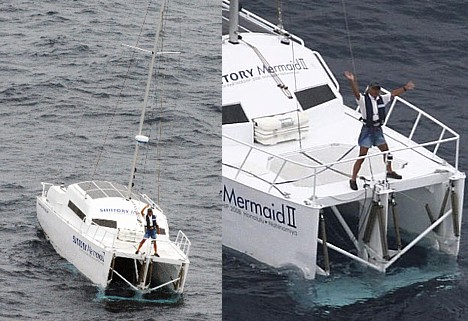
On July 2, 108 days after departing from Hawaii on the world's longest voyage in a wave-powered boat, 69-year-old Japanese sailor Ken'ichi Horie was spotted in his boat off the coast of Japan. The solo sailor of the wave-powered Suntory Mermaid II was seen about 50 kilometers (31 mi) offshore south of the Cape of Muroto (Kochi prefecture), heading northeast toward his final destination, the Cape of Hinomisaki in the Kii Channel (Wakayama prefecture), where he is expected to arrive on the evening of July 3.
The 6,400-kilometer (nearly 4,000 mi) journey, which appears to have taken 5 to 6 weeks longer than originally planned, can ordinarily be completed by a diesel-powered boat in about 10 days. However, the Suntory Mermaid II, a 9.5 meter (31 ft) long x 3.5 meter (11 ft) wide, 3-ton vessel made of recycled aluminum, does not use an engine for propulsion. Instead, it relies on a pair of fins under the bow that move up and down as the waves come in, propelling the boat forward.
Horie, who was reached on his cellphone by an Asahi reporter, said he was in good physical shape and that the boat was in perfect working order, but that the increased boat traffic around Japan was forcing him to pay extra attention to safety.
[Source: Asahi]
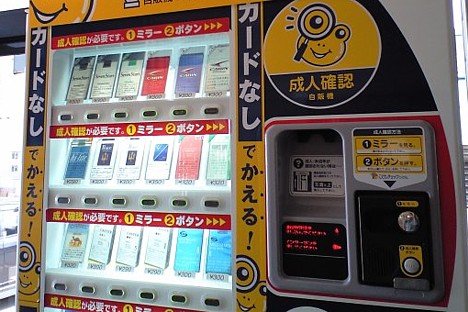
With the full-scale rollout of Japan's cigarette vending machine age-verification system just around the corner, a Sankei Sports news reporter has confirmed the existence of a minor flaw: magazine photos can be used to fool the age-verification cameras on some machines.
When the reporter went to check out the new age-verifying machines after they were introduced in the Osaka area in June, he soon discovered that the machines equipped with face-recognition cameras would let him buy cigarettes when he held up a 15-centimeter (6-in) wide magazine photo of a man who looked to be in his 50s.
The reporter also went to Kobe, where different face recognition hardware is being used. There, he bought cigarettes using an 8-centimeter (3-in) wide magazine photo of a female celebrity in her 30s. He also reportedly tried to use a 3-centimeter (1-in) wide photo, but the machines rejected it.
 As part of the age-verification system, most of Japan's 570,000 cigarette vending machines are being outfitted with RFID readers that check the purchaser's Taspo age-verification card. Smokers without a Taspo card can now either buy their cigarettes in person over the counter or use one of 4,000 special machines equipped with face-recognition systems (these machines do not require Taspo cards). More face-recognition machines are on the way, according to vending machine manufacturer Fujitaka, who developed the face-recognition hardware.
As part of the age-verification system, most of Japan's 570,000 cigarette vending machines are being outfitted with RFID readers that check the purchaser's Taspo age-verification card. Smokers without a Taspo card can now either buy their cigarettes in person over the counter or use one of 4,000 special machines equipped with face-recognition systems (these machines do not require Taspo cards). More face-recognition machines are on the way, according to vending machine manufacturer Fujitaka, who developed the face-recognition hardware.
The face-recognition machines rely on cameras that scan the purchaser's face for wrinkles, sagging skin and other signs of age. Facial characteristics are compared with a database of more than 100,000 people, and if the purchaser is thought to be well over 20 years old (the legal age), the sale is approved. If the purchaser looks too young, they are asked to prove their age by inserting a driver's license. According to Fujitaka, the machines are 90% accurate.
Fujitaka admits that people may, on occasion, be able to fool the age-verification cameras with photographs -- but only for the time being. The company is now working on a more advanced system that will make sure each face belongs to a real human, but they are unable to say when these new machines will be put into place.
[Source: Sanspo]
 IT company Kayac has teamed up with researchers from Keio University to develop a high-tech brainstorming room that listens to its inhabitants and feeds them a barrage of related data and images in order to boost creativity and fuel the imagination.
IT company Kayac has teamed up with researchers from Keio University to develop a high-tech brainstorming room that listens to its inhabitants and feeds them a barrage of related data and images in order to boost creativity and fuel the imagination.
The system -- called "Kage Roi" -- relies on a speech-recognition capable computer that monitors the brainstorming session via microphone, identifies keywords, and automatically crawls the web in search of related information and images. A ceiling-mounted projector then casts the retrieved data and imagery onto dark, human-shaped shadows on the table during the course of the meeting. The brainstormers can free-associate on the projected data, use it as a tool for discussion, or rely on it for helpful cues if ideas are running short.
Kage Roi also features an ambient, multi-colored LED lighting system designed to stimulate creativity by altering the mood of the room. The "half-day course" setting, for example, simulates the rising and setting of the sun over the course of a 2-hour brainstorming session, helping to create a gradual mood shift as the meeting progresses.
Kayac developed Kage Roi in cooperation with the Keio University Inakage Lab (imgl), whose research focuses on next-generation digital communication and entertainment. The system was installed in a meeting room at Kayac headquarters last month, and the company plans to begin field-testing it soon.
Kayac hopes to develop a practical version of the system in the near future, and they are considering marketing it to companies in the content creation industry.
[Source: Fuji Sankei, Kayac]
Kaiju collector/photographer Red Yoda adds a touch of colorful madness to an awesome collection of Japanese vinyl monster figures. Browse the entire photoset for more.

[Kameba]
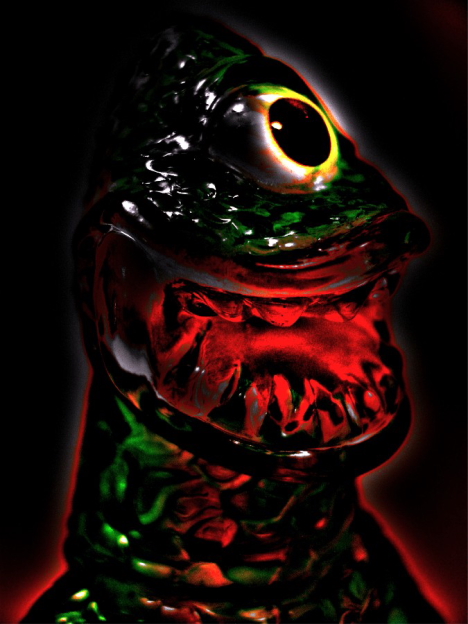
[Zag!]
Rice-growing season has only just begun, but this year's first crop of rice paddy art, which is created by planting various colors of rice in the field, has already started to emerge.
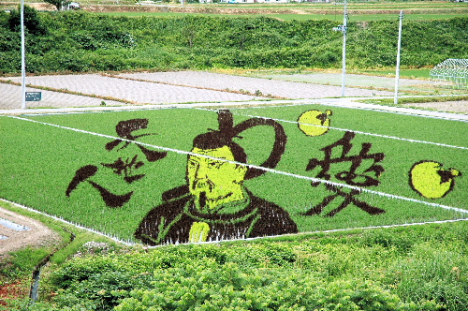
In the Yamagata prefecture town of Yonezawa, an image of 16th-17th century samurai Naoe Kanetsugu has appeared in a field near the Onogawa hot spring. The samurai, whose image is based on a portrait housed at the nearby Uesugi Museum, appears along with a pair of fireflies and the kanji characters for "Love" and "Tenchijin," the name of an NHK drama about Naoe Kanetsugu that will air next year. The rice will be harvested in October.
This year marks the third time that crop art has been grown in Yonezawa. Here are a few photos of works from the past two years.
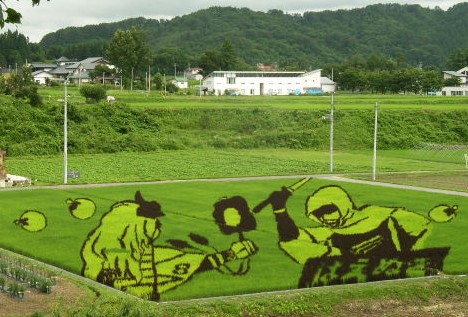
2007

2007

2007
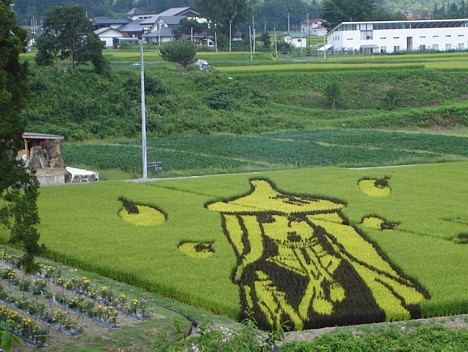
2006
In recent years, a growing number of local governments around Japan have started organizing rice paddy art projects as a way to attract tourists and educate people about rice farming. Look for more rice paddy art to crop up in the coming weeks.
[Photos: Asahi, chosasi_Bkyu]